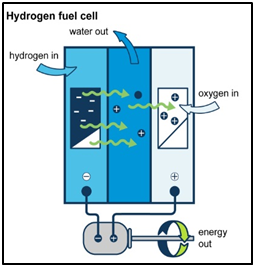PM Modi launches hydrogen-powered ferry
01-03-2024
01:11 PM
1 min read
What’s in today’s article?
- Why in news?
- What is Harit Nauka (green boat) initiative?
- What are hydrogen fuel cells?
- News Summary: PM Modi launches hydrogen-powered ferry
- What are the features of the f hydrogen-powered ferry?

Why in news?
- Prime Minister Narendra Modi on Wednesday virtually launched India’s first indigenously developed hydrogen fuel cell ferry.
- The vessel, manufactured by Cochin Shipyard Limited (CSL), will be deployed for service at Varanasi in Uttar Pradesh.
- The hydrogen fuel cell system was developed by KPIT Technologies, Pune, in collaboration with the Council of Scientific and Industrial Research Labs, under the Union Ministry of Science and Technology.
Harit Nauka (green boat) initiative
- This is the initiative of the Ministry of Ports, Shipping and Waterways. It envisages a green transition of inland vessels.
- In January 2024, the shipping ministry unveiled the Harit Nauka guidelines for inland vessels.
- As per the guidelines, all states have to make efforts to use green fuels for 50 per cent of inland waterways-based passenger fleets in the next one decade, and 100 per cent by 2045.
- This is to reduce greenhouse gas emissions as per the Maritime Amrit Kaal Vision 2047.
- In line with this, the ferry can be replicated in other parts of the country for urban mobility. It is also a boost to the National Green Hydrogen Mission.
Hydrogen fuel cells
- About
- A hydrogen fuel cell uses the chemical energy of hydrogen to produce electricity.
- It is a clean form of energy with electricity, heat and water being the only products and by-products.
- Working
- Fuel cells work like batteries, but they do not run down or need recharging. They produce electricity and heat as long as fuel is supplied.
- A fuel cell consists of two electrodes—a negative electrode (or anode) and a positive electrode (or cathode)—sandwiched around an electrolyte.
- A fuel, hydrogen in this case, is fed to the anode, and air is fed to the cathode.
- A catalyst at the anode separates hydrogen molecules into protons and electrons, which take different paths to the cathode.
- The electrons go through an external circuit, creating a flow of electricity.
- The protons migrate through the electrolyte to the cathode, where they unite with oxygen and the electrons to produce water and heat.
- Limitations in India
- High Cost:
- Fuel cell systems are still relatively expensive compared to traditional energy sources.
- Lack of Infrastructure:
- India currently lacks the infrastructure needed to support the widespread adoption of fuel cell technology, including hydrogen production and distribution networks.
- Technical Challenges:
- Fuel cell technology is still in its early stages of development, and there are ongoing technical challenges.
- Policy Limitations:
- The Indian government has yet to put in place a comprehensive policy framework to support the development and adoption of fuel cell technology.
- This has limited the growth of the industry and hindered investment in research and development.
- High Cost:
- Steps taken by India
- The National Green Hydrogen Policy has been developed to outline a vision for the growth of the hydrogen and fuel cell industry in India.
- The aim of the National Green Hydrogen Policy is to make India the Global Hub for production, usage and export of Green Hydrogen and its derivatives.
- The National Green Hydrogen Policy has been developed to outline a vision for the growth of the hydrogen and fuel cell industry in India.
News Summary: PM Modi launches hydrogen-powered ferry
- PM Modi virtually launched India’s first indigenously developed hydrogen fuel cell ferry.
- The Ministry of Ports, Shipping and Waterways met 75 per cent of the project cost.
Features of the ferry
- Length and carrying capacity
- The Hydrogen fuel cell vessel is a 24-meter-long catamaran, which can carry 50 people in its air-conditioned passenger area.
- Does not use conventional batteries
- Hydrogen fuel cell vessels do not use conventional batteries as the primary storage house of electrical energy.
- The vessels run on hydrogen fuel, which is stored in cylinders.
- This boat has five hydrogen cylinders that can carry 40kg of hydrogen and support eight hours of operations.
- The vessel is also fitted with a 3-kW solar panel.
- Type of cells used in the vessel
- This vessel uses a 50-kW PEM (proton-exchange membrane) fuel cell, with Lithium-Ion Phosphate batteries.
- The advantage is that the cells can quickly change their output depending upon the power demand.
- PEM fuel cells are popular in automotive applications because they operate at a lower temperature, and are lighter and more compact.
- This vessel uses a 50-kW PEM (proton-exchange membrane) fuel cell, with Lithium-Ion Phosphate batteries.
- Environment friendly
- The hydrogen fuel cell-powered vessel has zero emission, zero noise and is energy-efficient, which makes it more environment-friendly.
- Since there are no moving parts, the ferry requires less maintenance than combustion vessels.
- Other benefits
- While hydrogen fuel cell technology has been under development for maritime applications, only a few countries globally have done demonstration projects.
- This ferry, thus, has given India an early mover advantage to tap the potential of hydrogen as an emerging green fuel in the marine sector.
Q1) What is Maritime Amrit Kaal Vision 2047?
Maritime Amrit Kaal Vision 2047 was launched by the Ministry of Ports, Shipping and Waterways with an ultimate goal to make India the global maritime leader by 2047.
Q2) What is Cochin Shipyard Limited (CSL)?
Cochin Shipyard Limited (CSL) is India's largest shipbuilding and maintenance facility. It is located in the port-city of Kochi, Kerala, India. CSL was incorporated in 1972 as a fully owned Government of India Company.
Source: PM Modi launches hydrogen-powered ferry: features, significance | Office of Energy Efficiency and Renewable Energy | US Energy Information Administration


